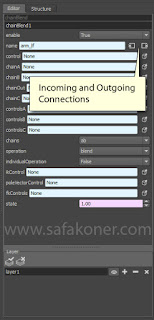Well, I am posting slower than I am developing. Last week I have posted regarding the Block V2 when I was about to release the third one. So here it is!
Since this is a major update I have edited the description as well, you can find it below or at
the related page.
Block is a node based application specifically designed for task building. I have developed the application by using Qt frame work both in C++ and in Python.
Standalone version has been specifically designed for batch and system related task building while the PyQt version has been specifically designed for rigging and animation tasks in Autodesk Maya.
Block allows users to create nodes which are driven by any API developed by you or third party. Created graph can be run within the Block application or attached to any batch process as needed.
Reusable nodes benefit entire production team from modeling to rendering while it’s bringing the cost down. It’s visual, fast and very easy to use. It’s also extremely flexible to handle any kind of work type thanks to its scalable API.
We use the Block on our productions mainly
for following tasks;
- Rigging pipeline
- Asset publishing
- Rendering pipeline
- Batch processes
- Automated & repeated tasks
While I am using it for;
- Doing system related tasks like renaming files (for
personal work as well)
- Compiling C++ codes
- Sending email if required by the conditions I created
Feature List
- Multi-Threaded
- Content and data aware structure.
- Dedicated attribute fields for types.
- Arrays of data types.
- Array capabilities for built-in Autodesk Maya types.
- Data and code export abilities for additional
pipeline purposes.
- Node integration with Autodesk Maya.
- Node creation integration for Autodesk Maya.
- Layers.
- Categorized blocks.
- Reporting.
- More built-in nodes.
- More flexible outliner.
- Color representation of data Types.
- Fancy node representation.
- Connection shape options.
- Full screen mode.
- Additional visual improvements.
- Many others…
The features above are also added
to the API.
Data Types
Block is a data and content aware system. Single and array types of attributes are supported. Following data types are available.
- str:
string
- int:
Integer.
- float:
Float.
- bool:
Boolean.
- enum-str: String
enumeration.
- enum-int: Integer
enumeration.
- mayaNode:
Data holds Autodesk Maya node(s).
- Generic:
Generic type is developed for handling any other kind of data type not
listed above. This type is treated as typeless structure. You can connect
or set any kind of data on them. Nodes intuitively convert it to required
data type.
Attributes and Content Aware System
I have introduced several new
cool features on the attributes in this version.
Attribute Features
Attributes may
require additional features like browsing a file, directory, selecting a node
in Autodesk Maya, even components like faces, edges, etc. So I have introduced
feature set for attributes to offer more flexibility interaction.
Available
features appear along side of attributes in the editor when a node selected. For
instance; if an attribute represents a directory, “Browse for a directory”
feature appears and allows users to interact with the attribute in efficient
manner. Following features are also available and new features can be added
very easily.
·
Browse for File
·
Browse for Directory
·
Select Maya Node
·
Select Maya Poly Face
·
Select Maya Poly Edge
·
Select Maya Poly Vertex
·
Select Maya Node Attribute
Color Coding
Color coding for
data types which reflected on the plugs and on the connections has been added
in previous version. I have also added color coding system on the attribute
editing fields in this version. So user can distinct the data types far more
easily by looking at the color of the attribute fields.
Dedicated Editing Fields
Unlike previous
version, this version comes with dedicated attribute editing fields for each
individual data types. Integer and float spinner boxes, combo boxes, etc.
Connections
Connections now
can be broken by individually for incoming and outgoing plugs. In previous
version this feature was designed to disconnect both at the same time.
Feedback
Since feedback is extremely important in every aspect of the production there is no exception in the Block application.
User can watch feedback panel for any information that the Block emits. While feedback panel gives written information about the performed action, nodes have a new feature to inform users regarding their state.
I have introduced “Flag” system in this version. A flag basically informs users visually regarding the stage of the action of the node while it appears slightly above of the each node. Green play icon means everything executed perfectly while red stop icon draws users attention for any possible error and emits written feedback regarding it.
Platform
Block is running on both
Microsoft Windows and Linux systems. It will be available for Mac OS in the future
as well.











